
29 minute read
Then replant the young, vigorous parts (usually from
Growing your own
Keep frost off early blossom
Drape fleece over flowering fruit trees, such as plums and apples, in the early evening if frost is forecast. Use wire ties or clothes pegs to hold it in place, attaching them to sturdy stems that won’t be crushed.
Small or trained trees, such as fans, cordons and espaliers, can usually be covered completely, but taller trees are more tricky to protect. You may only be able to wrap the lower branches. If any soft fruit bushes, such as currants and gooseberries, come into flower this month, protect these from frost too.
You can remove the fleece the following morning, once the temperature has risen above freezing. This gives flying insects access to the flowers to pollinate them.
Frost can be deadly to delicate blossom, damaging the anthers and stamens, meaning that pollination can’t take place. The flowers may then fall and won’t set fruit.
Prune out any frost-damaged shoots from your flowering shrubs. QUICK & EASY
Mulch fruit bushes

Spread mulch around fruit trees and bushes. It will deter weeds from germinating, hold moisture in the soil and improve soil structure.
First remove any weeds, then soak the soil with plenty of water. A thick layer of well-rotted manure is ideal. Alternatively, sprinkle general fertiliser over the soil then mulch with less nutritious garden compost or leafmould.
Sow courgettes
Courgettes dislike root disturbance, so sow just one seed per pot to avoid having to thin out the seedlings later. Seeds should germinate in a week or so.
TOP TIP
Give your containerised fruit trees a boost – scrape away and discard the top layer of compost, then replace this with fresh compost mixed with fertiliser. Water in well.

Place collars around the stems of newly planted brassicas to keep cabbage root fly at bay. This prevents the female flies laying their eggs close to the base of young plants. Use purpose-made collars or make your own out of cardboard or thick weed-suppressing membrane. Make the disc-shaped collars at least 8cm in diameter. Protect your brassicas
Sow seeds singly into 9cm pots, pushing them 2cm deep. Position them edge side down – if sown flat they are more likely to rot.
After watering, place them in a heated propagator at 18°-25°C until shoots appear. Then move them into the more open environment of a warm greenhouse, until ready to plant out in early summer. 1 2
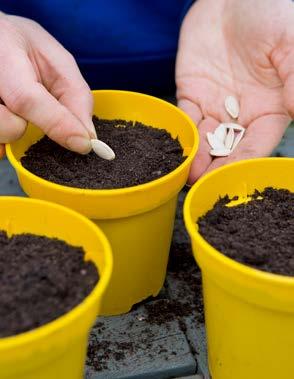
Harvest rhubarb There’s a knack to picking rhubarb without leaving stubs of snapped stems. Pick from the outside of the clump, holding the stem low down, and twist it firmly away from the plant. You can continue to pick through the season but stems are most tender in spring. Leave some stems to give the plant energy, but remove the toughest old stems to keep new growth coming.
Mulch around the plant with well-rotted manure to encourage leaf growth. Cut off emerging flower stems and apply a nitrogen-rich liquid feed to discourage any more.
AND DON’T FORGET TO...
Position supports for herbaceous perennials to grow into so they won’t flop
Check fruit cages and netting for holes that could allow pests in
Give the lawn a boost with a high-nitrogen spring feed
Use sheets of newspaper to protect seedlings in greenhouses from scorching on sunny days
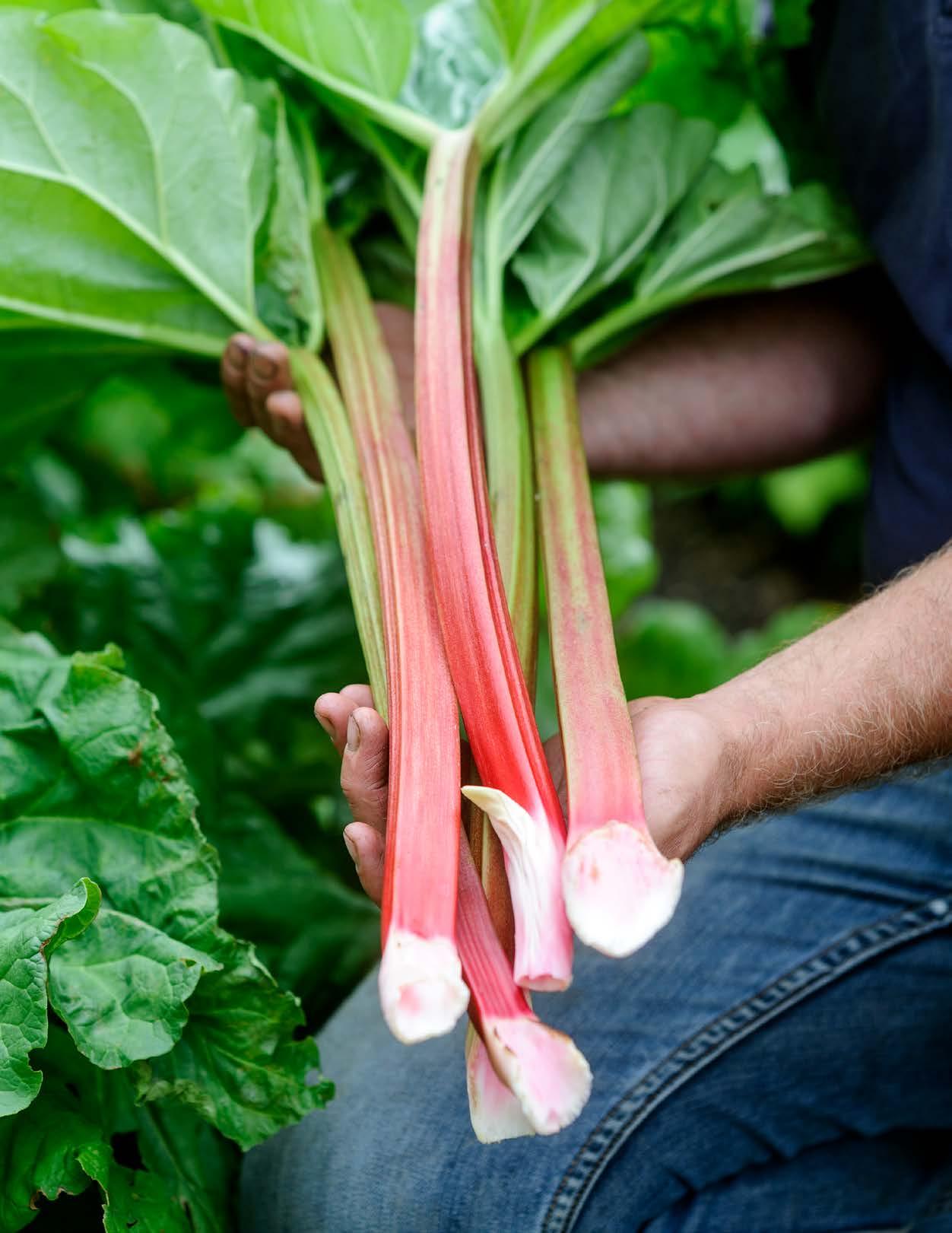
Keep potting on seedlings to prevent a check in their growth
Plant out autumn-sown hardy annuals
Lift and divide perennials – use the new plants to fill gaps in borders or share them with friends
Feed shrubs and hedges with bonemeal
Tie new shoots of climbers, such as honeysuckle and clematis, to their supports
Plant potatoes in bags on the patio if you run out of space on the veg plot
Water pots regularly as they can dry out quickly
Mow the lawn every two weeks

May
In May, it can feel like winter one day, then midsummer the next. But mostly the days are full of light and at least some warm sunshine. There is blossom everywhere, and a growing fullness in hedges and borders. Lawns are lush and green as spring shifts into summer, and weeds are growing faster than anything else. At times it can feel like there’s too much to do, but don’t worry. Over the following pages we’ll help you focus on the priorities. These include getting climbers and plants under control, and keeping on top of the veg patch as everything starts to accelerate.
KEY TASKS
Alliums such as ‘Purple Sensation’ add long-lasting sculptural interest, with showy flowers followed by striking seedheads
Prune Sow Plant Harvest Early springflowering shrubs – such as weigela, after flowering Hardy fuchsias Trained pyracanthas Outdoors:
Annuals, such as California poppies; cauliflowers, chard and spinach, French and runner beans, sprouting broccoli, peas, salad leaves, sweetcorn Indoors:
courgettes, marrows, pumpkins Dahlia tubers Hanging baskets indoors Hardened-off veg seedlings of cabbages and leeks Summer bedding, after the last frost Asparagus Beetroot Broad beans Lettuces Rhubarb Spring onions
May planner
T 26 W 27 T 28 F 29 S 30 S 31 How to get ahead Prune shrubs after flowering Mow lawns regularly Ventilate the greenhouse Harden off tender plants Thin out seedlings

Notes
1Aquilegias Varieties such as ‘Chocolate Soldier’ offer dainty flowers in unusual colours. Flowers May-Jun H x S 30cm x 25cm
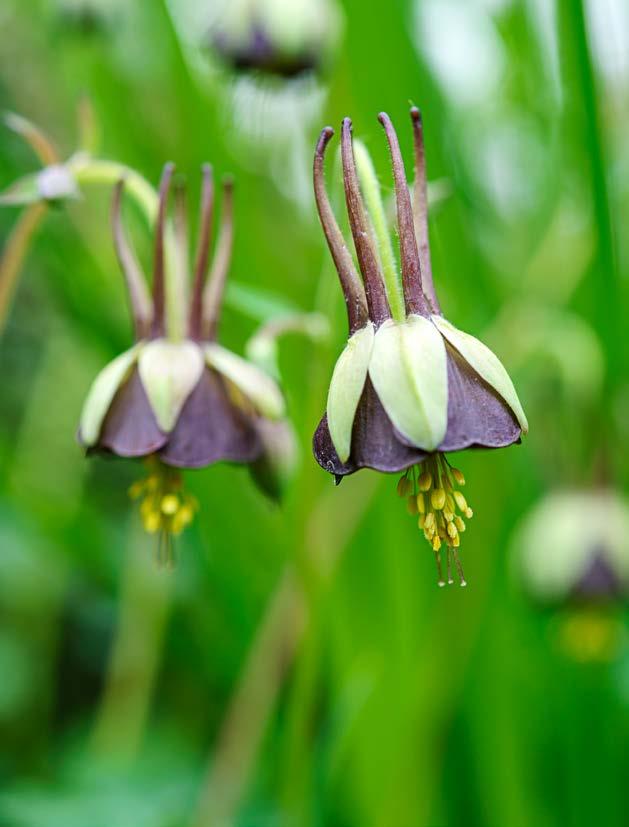
4 star plants

Solomon’s seal The arching stems of Polygonatum are hung with white bell-like flowers. Flowers May-Jun H x S 1.5m x 30cm 2
for May
3Lily of the valley Convallaria produces small but highly scented flowers in a shady spot. Flowers May H x S 25cm x 30cm

Choisya ‘Aztec Pearl’ is a compact form of this popular evergreen shrub. Flowers Apr-May H x S 2.5m x 2.5m 4

What to do this month
Discover how to keep your garden looking its best with our selection of key tasks for May
Around the garden
Feed your lawn
There’s still time to give your lawn a quick boost with a highnitrogen lawn feed. Most granular fertilisers contain a mix of other essential nutrients too, for general health and hardiness.
Follow the packet instructions and measure the dose carefully. Scatter the fertiliser evenly over the lawn on a day when rain is forecast. Water well if it doesn’t rain much. You should see the difference in just a couple of days.
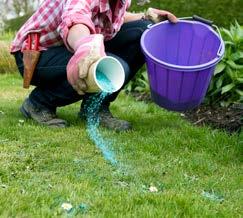
Tie in young climbers
Some climbers, such as clematis, may need some initial help to cling to their supports. New stems sprawl out looking for something to climb, and if you tie these to the support you can direct them where you want them to go. Once the basic framework of stems is in place, the plant should keep going on its own.

Tie soft string to the wires or frame at a point where the stem can be easily drawn across to it. Young stems, especially those of clematis, can be fragile, so be gentle. Tie in the stem with a large loop, which will give it plenty of room to thicken up as it grows. 1 2


1
2
LOOK OUT FOR perennial weeds – these long-lived plants form sturdy roots, so weed them out before they get established.

Trim hedges
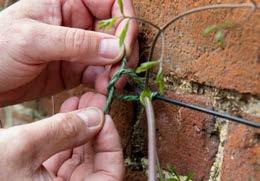
Pinch out the tips of seedlings in the greenhouse
Seedlings should be growing strongly by now and will keep getting taller if you let them, with the top buds producing the dominant growth. This can lead to top-heavy plants on weak main stems. So pinch out the tip above a set of leaves lower down the stem. The more you remove, the sturdier the plant will become. New sideshoots will sprout from the remaining leaf nodes, making the plant bushier and able to carry more flowers. Formal hedges are best trimmed a couple of times in summer to keep them neat. Electric shears make light work of it, but hand shears do a good job, too. Before you start, always check for birds’ nests and delay trimming for a few more weeks if you find any that are in use.
Put a groundsheet down to catch the clippings, then trim from the bottom upwards. Use a measure to keep the top level.
In your flower patch
Plant up a summer pot
A large pot on the patio can make a bold focal point. Big containers retain moisture and nutrients for longer, and have greater impact than several smaller pots. When choosing plants, go for high drama – thrillers, fillers and spillers, the latter to cascade over the edges. For height, add a wigwam of canes and some flowering climbers.
Good drainage is vital, so don’t block the hole in the base. Use a 50:50 mix of multi-purpose compost and John Innes No.2. Apply dilute liquid tomato feed every couple of weeks after the first month, to encourage flowering. Deadhead regularly and rotate the pot occasionally for even growth.

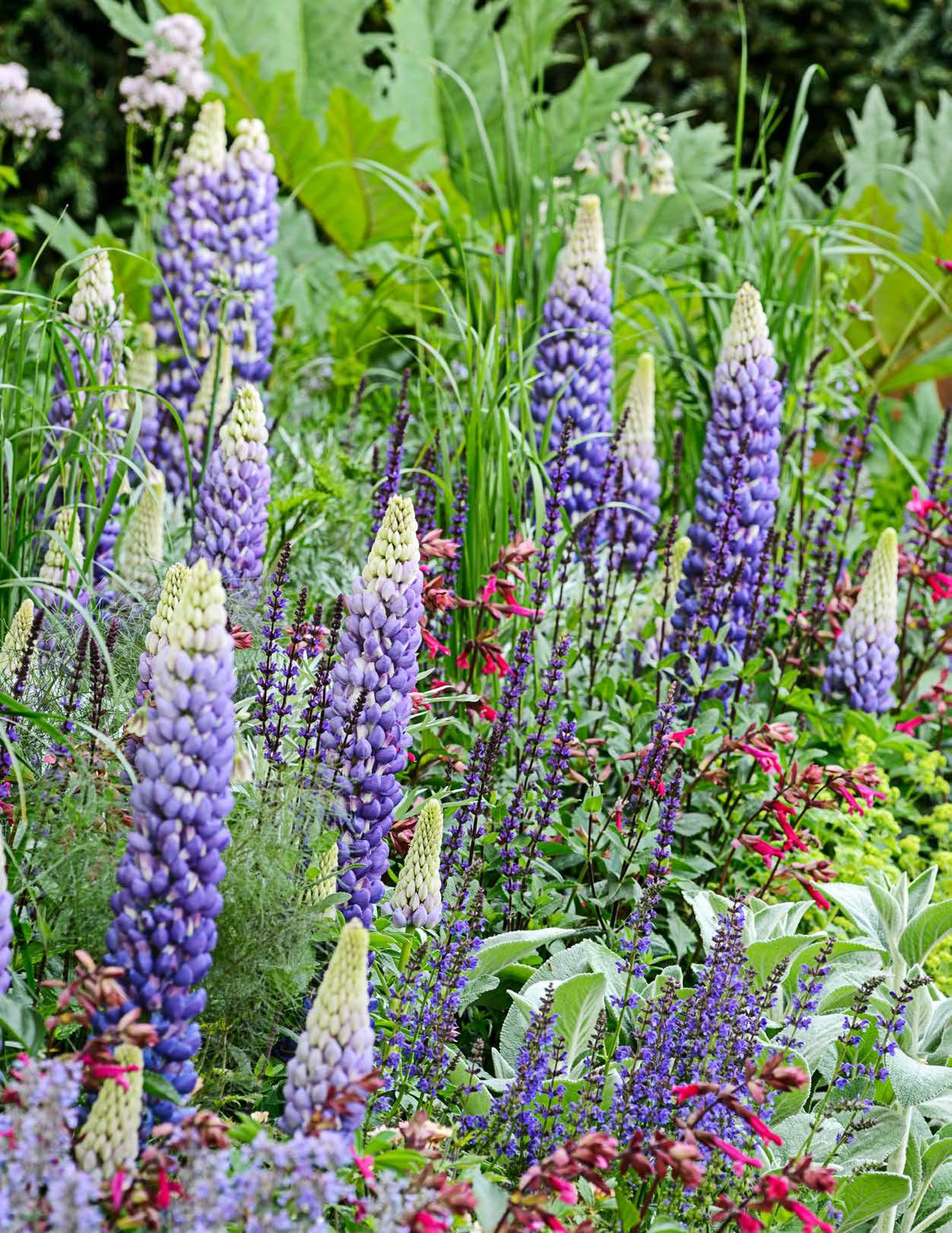
Top plants for containers Begonias, petunias, pelargoniums, dahlias and fuchsias, climbers such as clematis, and spillers such as trailing campanulas or lobelias.
Look after lupins These border favourites add height and colour, with flower spikes in a range of vibrant two-tone hues. Once the flower spikes are spent, remove them at the base to encourage more to form. Check plants regularly for grey lupin aphids clustering on the stems. Rub them off by hand, wash off with a hose, or cut off infested spikes.
Do the Chelsea chop

Extend the flower display in borders with an easy pruning technique known as the ‘Chelsea chop’. This involves cutting back the stems of certain perennials, so flowering is delayed for a few weeks. It works well on many border favourites, including heleniums, rudbeckias and sedums. If you only have a single clump of a particular plant, then cut back half of its stems by half their height. Those left uncut will bloom first, followed by those you cut back, so overall flowering lasts longer. If you have several identical plants, you can cut back a whole clump, so it flowers after the others have finished.
1 0 M I N U T E S
Water permanent pot displays regularly – in warm weather they’ll need daily watering. QUICK & EASY
Keep deadheading

Removing spent flowers is a simple yet satisfying job that keeps displays looking their best. Faded petals often discolour or turn brown, marring the overall look. Dead petals also attract mould, especially in damp weather. It’s a great way to boost or extend the display too, as it encourages plants to make more blooms rather than seedheads. If you remove spent flowers, most herbaceous plants, including these primulas and pansies, will keep on making new flowers in an attempt to produce the seeds that will give rise to their next generation.
5 £5 issues for ● Special Subscription Offer ● Special Subscription Offer ●
Try a subscription to BBC Gardeners’ World Magazine with 5 issues for just £5! Plus, after your first 5 issues you’ll pay just £27.60 every 6 issues – saving 16% † .

Subscriber Club benefits
Experience more as a BBC Gardeners’ World Magazine Subscriber Club member
Great savings on the magazine cover price Your own Subscriber Edition with exclusive cover and Subscriber Club pages, plus quarterly newsletters Free delivery direct to your door Exclusive money-saving offers and discounts on plants, products and BBC Gardeners’ World Live tickets Just for you –Subscriber events and opportunities to meet the magazine’s experts
PLUS Unlock the Secret Garden – a Subscriber-only area of gardenersworld.com with extra features, videos and offers

Take easy cuttings
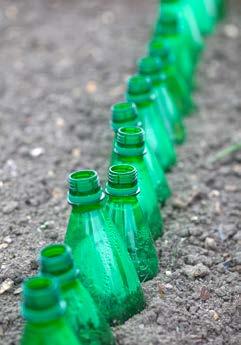
Now is the time to take softwood cuttings from non-flowering shoots of shrubs such as this fuchsia. These will root quickly and easily, but need careful tending, as they’re prone to rotting.
After planting, place in a propagator to root, but remove the lid for an hour most days to air it out and deter fungal rot. Pick off any leaves that start to wither.
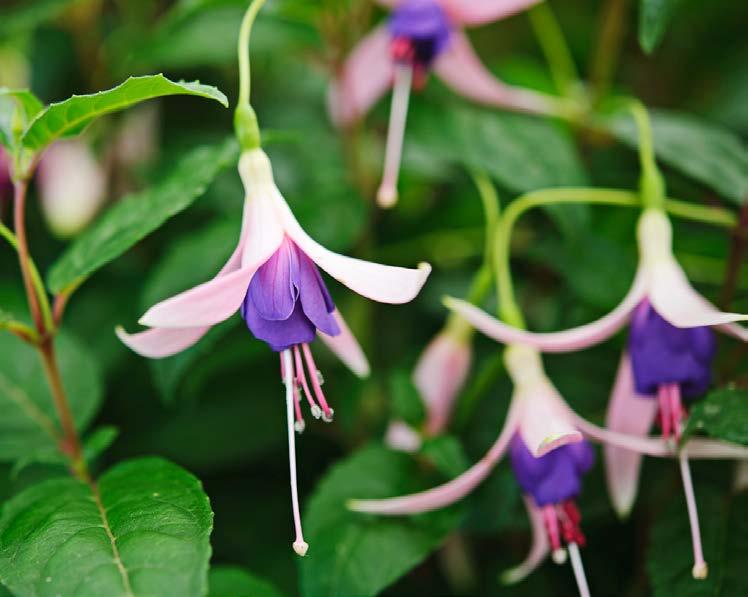
The cuttings should root within a few weeks. Test this when you see new growth by gently pulling the cutting – it should resist. Move the pot into a bright spot to grow on. Repot the new plants individually when you see roots through the drainage holes. Pinch out shoot tips to make plants bushier. They’ll be large enough to plant into borders next year.
Recycle plastic bottles
Turn old plastic bottles into mini cloches to protect your young plants. Simply cut off the bottom of the bottles, then place over individual plants. Unscrew the cap to improve ventilation. In the warm, protected atmosphere, the plants will grow more quickly. They’ll also be less accessible to snails, especially if you use narrow-necked bottles.
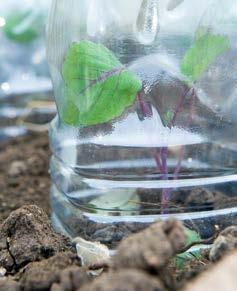
Offer ends 30 April 2020

2 EASY WAYS TO SUBSCRIBE
Call03330 162 123 * Quote code GWSPRING20 (Lines open 8am-6pm weekdays, 9am–1pm Saturdays)
Visitwww.buysubscriptions.com/GWSPRING20
†This offer is only open to new UK Direct Debit customers subscribing to BBC Gardeners’ World Magazine. You will pay £5 for your first 5 issues, £27.60 every 6 issues – saving 16% on the usual shop price. The closing date for this offer is 30 April 2020. You may cancel at any time and receive a full refund on any outstanding issues by contacting your bank or building society. Written confirmation may also be required. We reserve the right to reject or cancel subscriptions at any point if the customer has previously cancelled their subscription during the trial period for that magazine or any other magazine in the Immediate Media portfolio. Prices are discounted from the full UK subscription price and include P&P. Standard UK subscription price: £65.40 / Europe and Republic of Ireland: €105 / Rest of the World: US$144 / USA and Canada: US$143.88 / Australia and New Zealand: A$164.*UK calls will cost the same as other standard fixed line numbers (starting 01 or 02) and are included as part of any inclusive or free minutes allowances (if offered by your phone tariff). Outside of free call packages, call charges from mobile phones will cost between 3p and 55p per minute. Lines are open Mon to Fri 8am–6pm and Sat 9am–1pm. For overseas subscriptions, call +44 (0) 1604 973731.
Select strong, healthy, nonflowering shoots. Cut them off just above a joint, with three sets of leaves. Place in a plastic bag and spray with water to keep them damp. 1
Trim the base of the shoot just below the lowest set of leaves. Remove all the leaves except the top set. Pinch out any buds at the tip. 2
Fill a small pot with cuttings compost. Make a hole with a dibber near the edge and insert the cutting. Plant several per pot, spaced evenly around the edge. 3
Firm in well, then soak with tepid water and place in a warm propagator with a lid. Alternatively, place on a windowsill out of direct sun and cover with a clear plastic bag. 4
WILDLIFE WATCH Check shrubs for birds’ nests before you start pruning to avoid disturbing them.
Growing your own
Mulch strawberries
Now that strawberry plants are in flower, cover the surface of the soil around them with a thick layer of clean straw. This has several benefits.
First, it provides a soft layer for the developing fruits to sit on, keeping them off the damp ground. It also prevents soil getting splashed onto the fruits during watering or rain. The layer of straw holds warmth in the upper layer of soil over night, which speeds up fruit ripening. It also holds moisture in the soil, so it is available to the plant roots, helping the fruits to swell.

Earth up potatoes, covering the shoots with soil as they appear, whether in the ground or in bags. QUICK & EASY
Train cordon tomatoes in the greenhouse
Interplant between slower crops

Sow quick-growing salad leaves, spring onions, radishes and beetroot into the gaps between slow-to-mature crops such as onions, leeks, parsnips, maincrop carrots and brassicas. Called intercropping, this is a great way to get maximum crops from a limited space. The idea is that fast-growing crops will be harvested before the slower crops expand to fill the space.
First remove any weed seedlings, then make a shallow drill in the soil between the longer-term plants, taking care not to disturb their roots.
Water along the base of the drill. Then sow the seeds thinly, according to the spacing on the packet, and cover with soil. 1 2

Cordon (or vine) tomatoes are unruly sprawlers that must be trained into single-stemmed fruiting plants if you want to get the best crop. Sideshoots often appear between the leaf stalks and the main stem. Check for these weekly and pinch out while they’re still small. Don’t pinch out the growing tip at the top of the plant – leave it to climb up the support.
Remove blackfly from broad beans
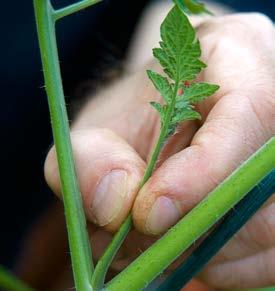
Keep watch for blackfly on the soft tips of your broad bean plants. This growth is easy for these aphids to feed on and a few individuals can turn into hundreds in no time at all. On small spring-sown plants and where there are only a few blackfly, they can easily be squashed by hand. On larger autumn-sown plants, pinch out the infested shoot tips.
LOOK OUT FOR Sawfly larvae on currants and gooseberries. These eat the leaves down to a skeleton. So stay vigilant and pick them off as soon as you spot any.
Plant blueberry bushes
There’s still time to plant blueberries for delicious harvests later this summer. These plants need acidic soil, rather than chalky or alkaline, so if you garden on the latter, grow them in pots of ericaceous compost. You will need two varieties to ensure pollination and fruit setting.
Keep the plants well watered (preferably from your water butt), mulch with well-rotted manure, and feed every spring.
AND DON’T FORGET TO...
Pot on aubergines, cucumbers and peppers
Damp down the greenhouse regularly to increase humidity
Throw fleece over new plants if frost is forecast

Sow seeds of herbs outdoors in prepared ground
Water and feed fruit trees in containers
Plant summer bulbs if you haven’t already
Transplant greenhouse tomatoes into large pots
Remove weeds from ponds
Water thirsty crops such as tomatoes regularly
Put supports in place for summer perennials
Remove any raspberry canes that are far from the rows
Net developing soft fruit
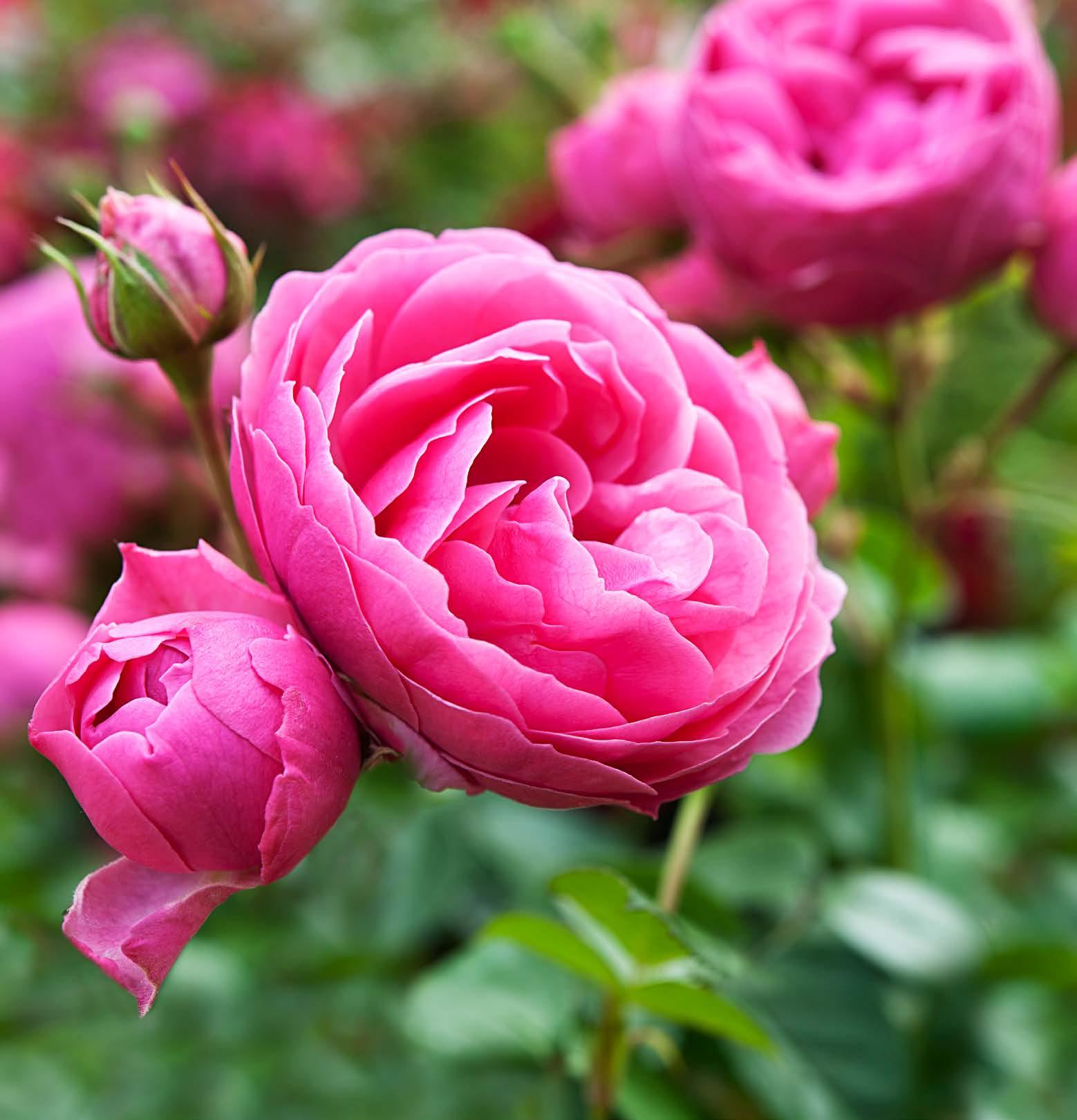
June
This month the evenings are long and everything is in full growth. The vegetable garden is progressing at speed, but certainly at the beginning of the month it’s still slow to provide much of a harvest. This is why crops such as early broad beans and peas, sown last autumn or at the very beginning of spring, are so welcome. Tender plants that we’ve been protecting for half the year can now be moved outside to grow freely. June is a busy month of sowing, planting and deadheading, as well as a time to enjoy the first early pickings and abundant flowers of early summer.
KEY TASKS
Floribunda roses such as ‘Pomponella’ start to open their opulent clusters of fragrant blooms
Prune Sow Plant Harvest Clematis montana and C. armandii Evergreen shrubs Gooseberries and currants Grapevines Lilac Spring-flowering shrubs Beetroot Pak choi Radishes Salads Turnips Chicory Leek seedlings Outdoor tomatoes Summer bedding Tender veg Cherries Gooseberries Early potatoes Salads
✹ ❂ ✺ ✺ ❂ ✺ ✷
How to get ahead Keep mowing lawns regularly Start preserving soft fruit Deadhead roses and other flowers soe seed of biennial flowers Look out for pests and keep them in check


1Hardy geraniums Varieties such as ‘Storm Chaser’ fill shady spots with flowers all summer. Flowers Jun-Aug H x S 30cm x 50cm
Notes
4 star plants

Astrantias Richly coloured ‘Burgundy Manor’ is a great choice for under trees. Flowers Jun-Aug H x S 75cm x 50cm 2
for June
3Peonies Glamorous bloomers like ‘Nippon Beauty’ are ideal in borders or as cut flowers. Flowers Jun-Jul H x S 75cm x 50cm
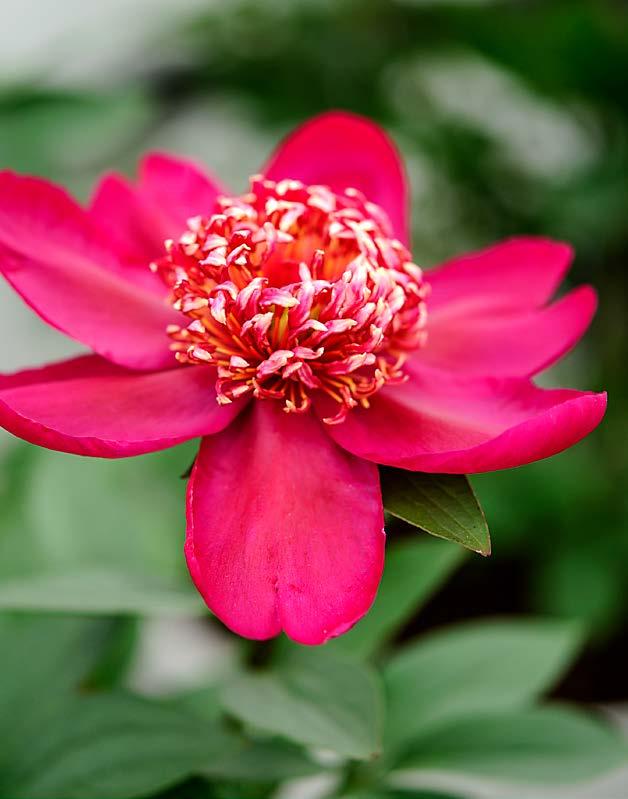
4Clematis Train these climbers, such as spectacular ‘Sieboldiana’, along walls or over arches. Flowers May-Aug H x S 2m x 1m

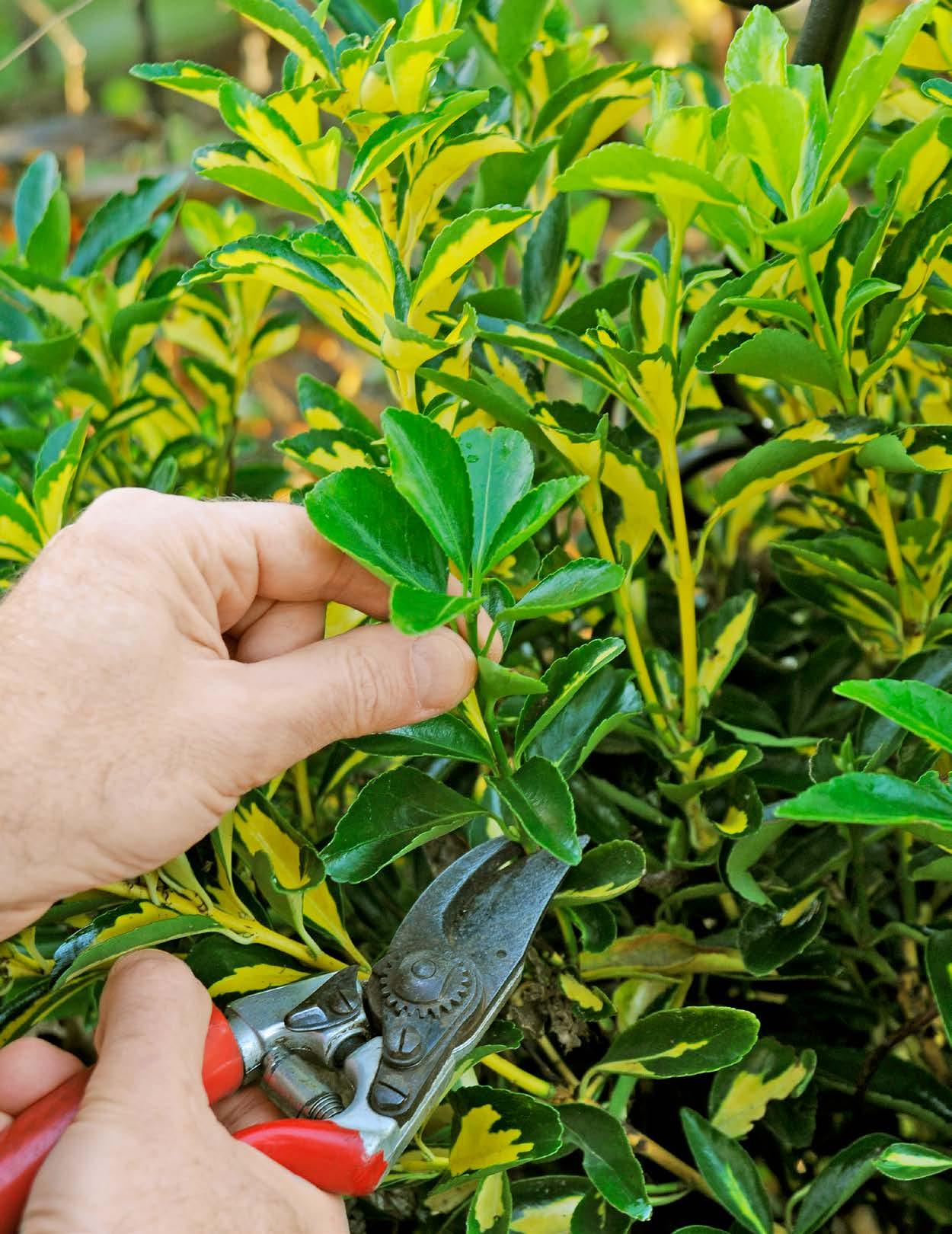
What to do this month
Enjoy a wide range of easy summer jobs, from planting and pruning to taking cuttings
Around the garden
Prune to maintain variegation
Check your variegated shrubs and trees for rogue stems that are entirely green, with no variegation. Trace these down to their base, where they sprout from a main branch, and cut them off. These shoots tend to be more vigorous than the variegated ones, so if you leave them to grow they will gradually start to dominate the plant.
Deadhead your roses
This is one of those gentle, relaxing jobs to do on balmy evenings throughout the summer months. Deadheading your roses regularly – even daily – will keep them looking their best and extend the display for as long as possible. Faded flowers not only look untidy but may even lead to fungal infections that can cause stem dieback. The process varies slightly, depending on whether the flowers are held in clusters or singly.
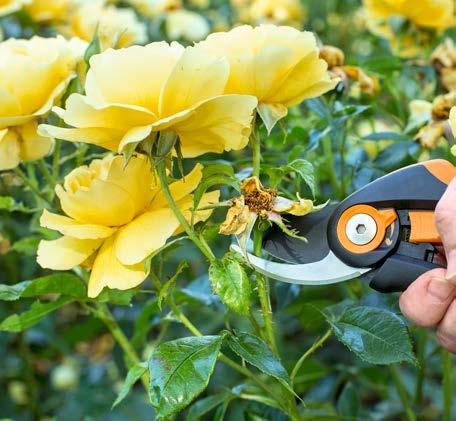
For multi-stemmed roses, cut each flower from the cluster as it fades. Once all the flowers in a cluster have gone over, remove the entire stem. For roses with single flowers, snip off the faded flower with about 15cm of stem, cutting just above a strong healthy leaf.
Water and feed greenhouse plants Keep your greenhouse plants healthy and growing strongly by watering and feeding regularly. A general-purpose fertiliser is ideal for most plants, but use a specialist feed for orchids and cacti. Slow-release granules in the compost can be boosted with a fortnightly liquid feed in the watering can.

Top up pond water
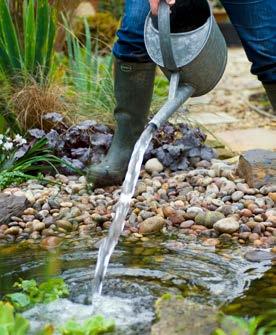
The sun can heat up ponds and cause rapid evaporation. Check the water level once a week and top up before it drops more than 2cm. Where possible, use rainwater from water butts to discourage algae. If you have to use tap water, topping up by small amounts means that any chemicals the water contains will be kept to a minimum and should dissipate quickly.
Keep topiary in good shape Ensure topiary looks neat by giving it a regular trim. Use clean, sharp shears and clip only into the outer two-thirds of the current year’s growth. Keep the blades of the shears flat to the surface and be careful not to dig in with the tip. Yew, holly and box are exceptions that will grow back from deeper cuts if reshaping is necessary.
Regular clipping encourages shoots to branch each time they’re cut, helping to create a dense surface to your topiary. Pick out any clippings that don’t fall to the ground.

TOP TIP Cool your greenhouse by pouring water onto the floor in the mornings. This will evaporate as the air heats up, cooling things down.
In your flower patch
Take pelargonium cuttings
Pelargonium cuttings taken now will root rapidly, as long as they’re given good light and free-draining compost. This is an easy and economical way to increase your stock of plants. A small propagator is helpful but not essential – a bright windowsill will be fine. Within a couple of months the plants will be ready to pot on, then should be kept indoors over winter for flowers next summer.
1 2 Remove several strong shoot tips from a healthy plant, making your cut with a sharp knife just above a leaf joint. Snap off all but the top pair of leaves (one large and one smaller one) and any flower stalks. Trim the cutting just below a leaf joint. Use a pen or dibber to insert the cuttings around the edge of a pot of gritty compost. Good drainage is vital, as these cuttings tend to rot in soggy conditions. Water them in and place the pot on the base of a heated propagator with the lid removed and keep the compost just damp.
1

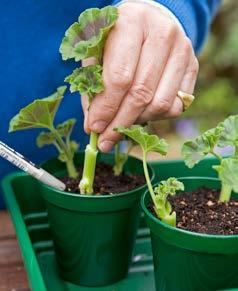
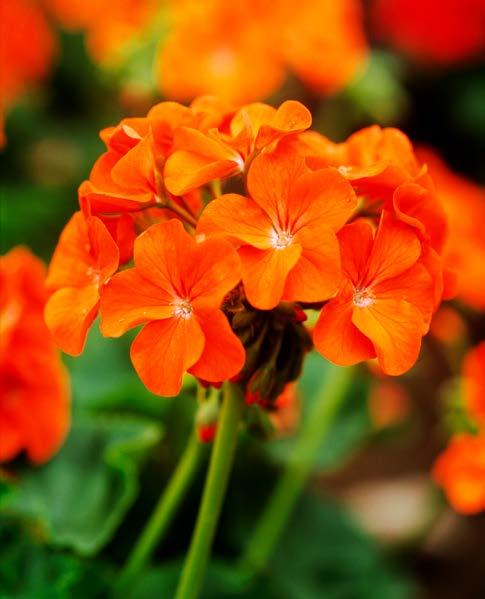
2
Show off your border flowers beautifully by neatening up your lawn edges – create a straight cut using a half-moon tool or flat-bladed spade. QUICK & EASY
Plant out tender annuals

It’s now warm enough to confidently plant out tender annuals such as petunias, salvias and nicotiana. In mild areas of the UK you could do this in mid-May, but it’s safer to keep them indoors until June so they suffer no setbacks. If you snip off the first flowers, the plants will strengthen up, then bloom soon after planting. Use a trowel to plant them, then firm and water them in.
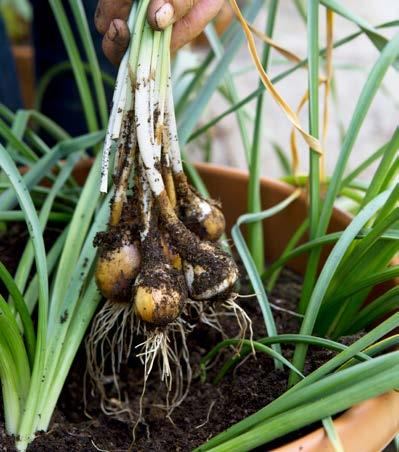
Move spent spring bulbs To free up space in pots and borders for summer bedding, dig up spring-flowering bulbs and replant in a temporary spot until their foliage dies down naturally. Lift the bulbs with as many of the roots as possible. Choose a sunny, open site away from your main displays, such as on the veg plot. Dig a hole and replant the bulbs at the depth they were before. Water in well, and apply a liquid fertiliser to boost growth. Then leave them, letting the foliage die down in its own time. Once this happens, you can lift and store the bulbs for replanting in prime positions this autumn. Many nerines are tender and need to be grown in a greenhouse, but N. bowdenii will cope outdoors in most areas of the UK, producing vivid-pink blooms in autumn. This beautiful species needs a sheltered, sun-baked spot in free-draining soil. Plant the bulbs at a depth equal to two times their height. Give nerines a try

Plant up a hanging basket
It’s not too late to create a hanging basket. The floral display is instant and it will last until the first frosts of autumn. Bedding plants such as pelargoniums, fuchsias, petunias and begonias are ideal. Choose a mix of plants that will trail over the edge of the basket and strong uprights that will give the display some height. You can colour theme your flowers for a harmonious display or go for strong contrasts to create a bold and joyful feature.
Ongoing care The shape of most baskets means there’s not much root space for all the vigorous plants that are sharing it. Giving them plenty of water and feed makes all the difference. Add fertiliser to the compost when planting, then apply a liquid feed regularly too. Water daily through the summer and snip off old flowers to encourage more.
If the basket is out of easy reach, rather than climbing up to it to water, you can get a retractable pulley to lower it for easy aftercare.
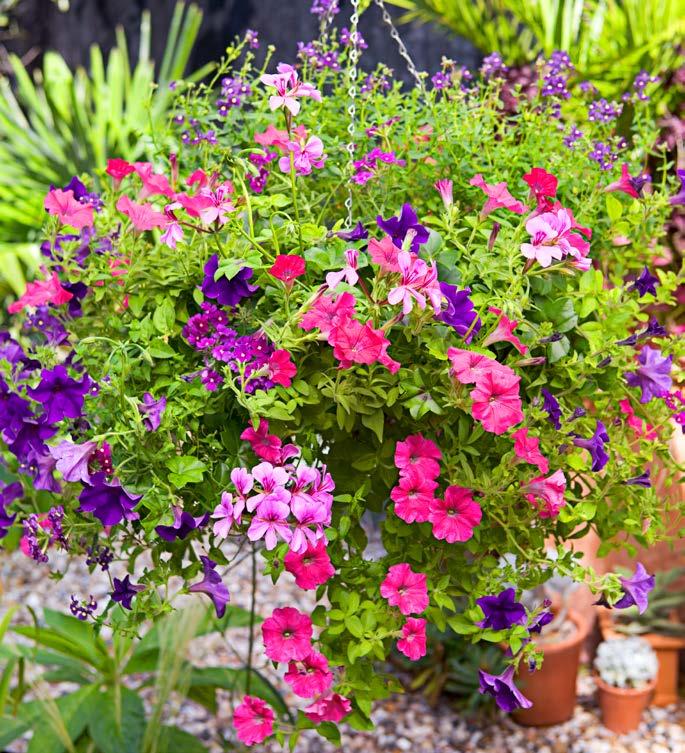


Use a large empty flowerpot to support the basket while you’re working on it. Gather together everything you’ll need – the liner, compost, plants, fertiliser and a watering can. 1

Line the basket with hessian, leaving plenty above the rim. Place an old compost bag with punctured holes inside. Fill with new multi-purpose compost mixed with water-retaining gel. 2

Mix in slow-release fertiliser and begin planting the lower plants through holes in the liner. Next add the taller central plants, and finally the trailers to cascade over the sides. 3

Trim the edges of the liner, then water well to soak the compost thoroughly. Allow it to drain before hanging it up. The plants will fill out over the coming weeks to create a ball of colour. 4
Growing your own
Harvest crops and fill gaps
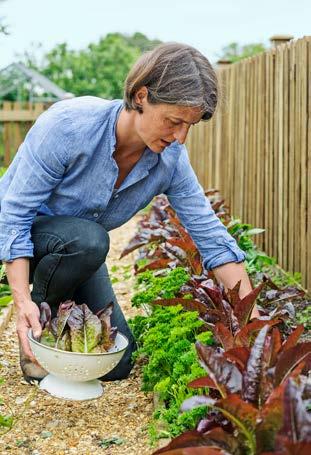
Keep picking broad beans and asparagus. Beetroot, turnips, kohl rabi and bunching carrots may be ready for pulling too. Lettuces, salad leaves and herbs are in full swing as well. It’s best to harvest these fresh whenever you need them, but you can store them in the salad drawer of the fridge for a few days if necessary. Where harvesting has cleared some ground, it’s a chance to grow a few more crops. Add a general fertiliser, then sow salad leaves, dwarf beans, plant leeks, courgettes or squash. 1 0 M I N U T E S
Water wisely
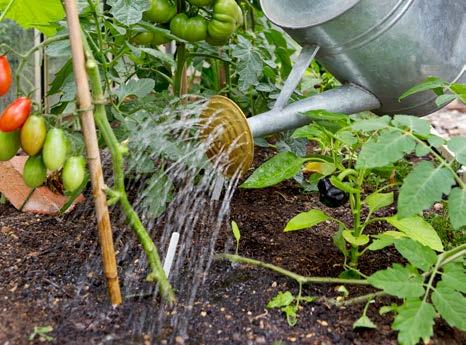
When water is scarce or you only have limited time, target your efforts carefully. Focus on new plantings, germinating seedlings and plants with swelling fruits. A generous watering every few days, rather than a light sprinkling every day, encourages roots to go deep in search of ground water. Avoid overwatering tomatoes when the fruits are ripening, as the flavour may be reduced.
Look beneath pots, bricks and mulch fabrics for snails and slugs, and remove. QUICK & EASY
Plant out dwarf French beans
Dwarf French beans grown from seed indoors can be planted out now. Prepare the ground by weeding thoroughly, then fork in lots of organic matter, such as well-rotted manure, as these are hungry plants. They’re thirsty too, so water them regularly. They’ll start flowering within a few weeks and will quickly form beans. These can be tricky to spot under the large leaves, so check the plants carefully. Harvest regularly to keep the supply coming.

Dig up early potatoes
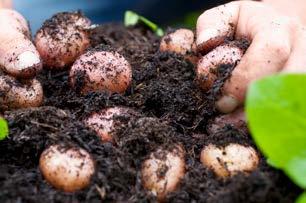
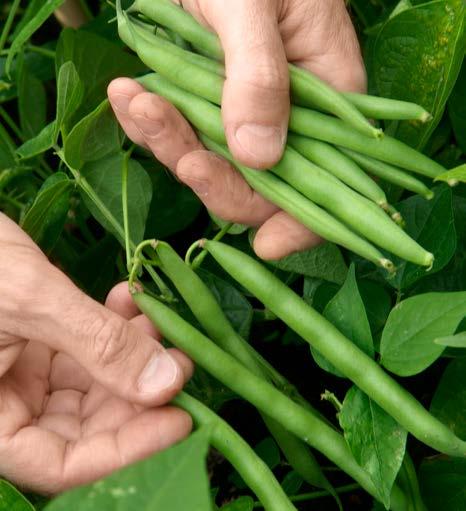
Early potatoes are growing rapidly, so wait for the plants to flower then start lifting them while they’re small and sweet. Carefully dig in a fork to lift the plant, then sort through the soil to find every tuber. For the best flavour, lift and eat on the same day, but allow the skins to dry if storing them. Leave maincrop plants with bigger tubers to grow. Lift these in late summer as your storage crop.
1Space plants 20cm apart and plant firmly into the soil leaving a slight depression to help direct water towards the roots.

These dwarf bushy plants will carry a weight of beans so are best supported with a short stick. Loosely tie in the stem and water the plants in well. 2
Pick soft fruit
Many soft fruits are ripening now, so make sure you pick them in the best way to avoid any wastage: Strawberries, gooseberries and raspberries should be picked individually. Hold the fruit gently to avoid bruising, and discard any fruits that are showing signs of rot. Pulling currants off the sprigs tends to crush the ripe fruits. It’s better to snip off whole sprigs, then pick through them back in the kitchen ready for eating, cooking or freezing.
AND DON’T FORGET TO...
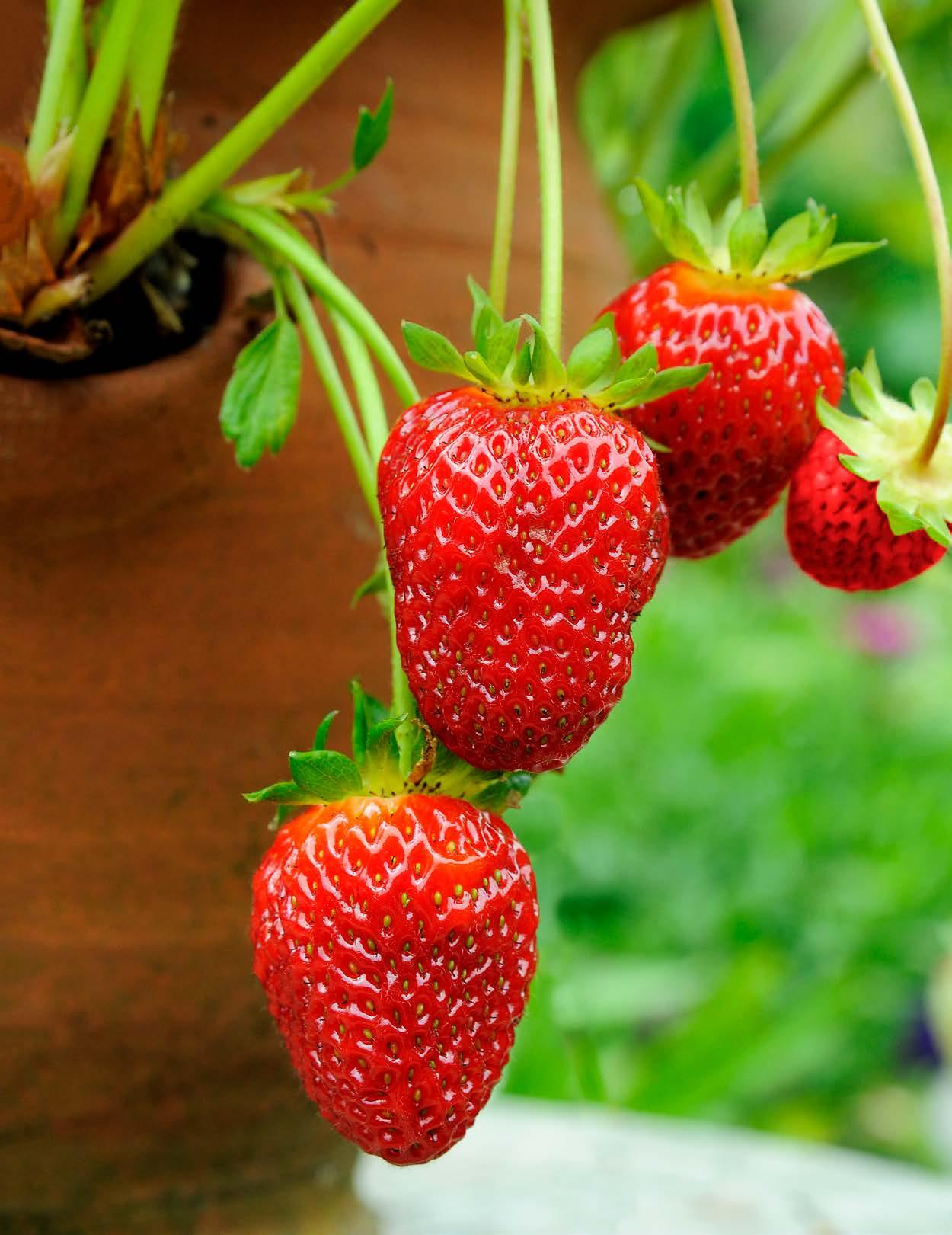
Stake flopping plants
Tie in the new stems of climbing and rambling roses
Keep picking out and potting on seedlings
Hand-pull weedsbefore they grow too large
Feed fruiting veg crops with tomato fertiliser
Rub greenfly off stems and shoots
Take cuttings from pinksand carnations
Feed container displays regularly
Keep pinching out sideshoots on cordon tomatoes
From YEAR PLANNER 2020 by BBC Gardeners’ World Magazine
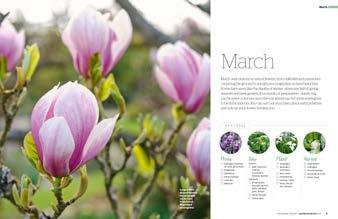
Space for notes Organise your gardening year



Essential monthly jobs Keep on track with handy checklists

Easy seasonal projects Follow clear step-by-step instructions
Monthly star plants Give your garden year-round interest
Fruit and veg advice Enjoy delicious homegrown crops




